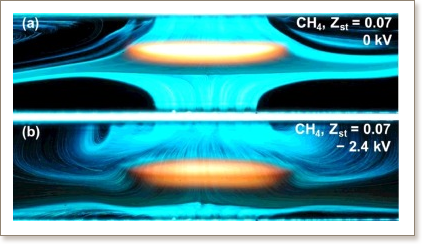

Bidirectional ionic wind in nonpremixed counterflow flames with DC electric fields
D.G. Park, S.H. Chung, M.S. Cha
Combustion and Flame 168, 138-146, (2016)

Under an electric field, ions in the reaction zone of a flame generate a bulk flow motion called ionic wind. Because the majority of ions are positive, ionic wind is commonly considered to be unidirectional toward the cathode. A more thorough understanding of the effects of electric fields on flames could be obtained by clarifying the role of minor negative ions in the ionic wind. Here, we report on the effects of direct current on nonpremixed counterflow flames by visualizing the ionic wind. We found that the original flow field separates near the flame when it locates at a flow stagnation plane, resulting in a double-stagnant flow configuration. This evidences a bidirectional ionic wind blowing from the flame to both the cathode and the anode due to the positive and the negative ions, respectively. Meanwhile, an electric body force pulls the flame toward the cathode. Thus, the electric field affects the strain rate and the axial location of the stoichiometry, which are important for characterizing nonpremixed counterflow flames. In addition, measurement of the electric current density roughly showed a nearly saturated current when these flames restabilized under relatively high voltage. Detailed explanations of flame behavior, electric currents, and flow characteristics of various fuels are discussed in this study.